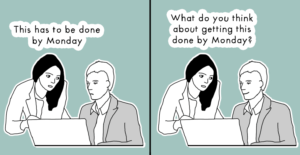You may have noticed the stories coming out in the media, with increasing frequency, about transphobic discrimination on the job.
Forever 21 called a trans woman “disgusting” before firing her. A trans woman had to dress and act “like a man” while working at Barnes and Noble. A trans woman was disallowed from using the bathroom and called “it” by supervisors in the Army. And a trans man was told that he had to “dress as female” in order to stay employed.
Part of the increased media attention is because there are now more legal protections for transgender employees, in many places. The media is starting to highlight the intensity of working while trans.
What they don’t tell you, however, is that these are not isolated incidents of transphobia — anti-trans discrimination is the norm.
Like many people dealing with oppression, trans people face a lot of BS at work. Some sources estimate our un/underemployment rates to be close to 50%. 90% of us report experiencing discrimination or harassment on the job.
A recent survey of hiring practices towards the most privileged trans people in Washington, DC found that 48% of workplaces would rather consider a less qualified cis person than a more qualified trans person.
And this is in a place where it’s technically illegal for employers to discriminate based on gender identity!
When you add in intersecting oppressions, the numbers skyrocket even higher.
Whether it’s overt bigotry or implicit bias from well-intentioned folks, being trans at work is perceived as inherently unprofessional. And worst case scenario, workplace discrimination and harassment can contribute to trans people experiencing assault, suicide attempts, poverty, and homelessness.
Because so many work environments are hostile, this means that we are denied promotions, education and skills development, mentorship, networking opportunities, and other opportunities to do our best work.
This contributes to all sorts of problems the trans community faces, from the fact that 25% of us live on less than $10,000/year to increased suicide attempt rates (it’s been found that trans people who face discrimination are more likely to attempt suicide).
Not only does it contribute to the struggles transgender people face, it also keeps the skills and potential we have from benefitting society.
In a culture that revolves around work and has little space for survival other than through employment, being allowed to work – safely, or at all – is fundamental for inclusion in society. (Assuming everyone must work in order to be valuable is ableist, too, but that’s an article for another time.)
Welcoming trans employees into your workplace will bring huge benefits to the trans community – and it will cast employers as forward-thinking actors for civil rights.
There are many ways employers can help to make a shift in this story.
If you are new to issues the trans community faces or haven’t knowingly interacted with many trans people, you might be thinking – “Okay, but what if I mess up? How can I do this right?”
Yes, it is an adjustment. But if you are making a good-faith effort to treat trans employees with respect, if you continually work on your knowledge and behavior, and if you are accountable to when you’ve made a mistake, you’ll be well on the road to making your workplace a more equitable place for everyone.
It’s certainly better than not trying at all!
This article is an overview of some of the most important things employers can consider and change. If you take these tips to heart, you’ll be off to a good start.
1. Let the Employee Take the Lead
We all need and want different things around our trans and a/gender identities in the workplace. What works for one trans person may not work for another.
Ask us what we need and the best way to approach our transness at work. Then follow suit.
2. Remember That You Are Setting the Tone and Modeling How to Behave
Make sure that you are doing your best to make trans people feel comfortable and safe at work, and that you ready to acknowledge mistakes and change direction.
Make it clear that there is room for everyone to learn and adjust, but that you expect everyone to make the necessary changes to ensure this is an a/gender-equal space.
3. Provide Trainings for Leadership, Staff, and Any Public with Whom You Interact
A basic trans cultural competency training is vital, and further trainings on specific aspects of trans identity might be needed as well. In addition, be sure to offer education for any public your organization serves.
Anybody that a trans person interacts with on the job, including if they are providing a service to someone, should affirm and respect that person’s a/gender identity.
Make sure that the responsibility of educating others is not on the trans person. In most places in the US, there should be a local or regional organization that can provide training.
4. Respect Names, Pronouns, and Gendered Language
One way to set many trans folks at ease in any space is to create a culture of asking people’s pronouns along with their names.
Another way to make a space more equitable for everyone is to refrain from using gendered language unless it’s specifically requested.
This includes using “Mr.,” “Ms.,” “sir,” and/or “ma’am.” Alternatives include saying “excuse me,” or adding a sincere “thank you very much” or “have a nice day.”
Make sure that this is consistently applied – both so that any out trans folks aren’t singled out, and because you never know who actually is trans, even in your workplace.
If someone uses multiple sets of pronouns, check in with them about how they would like those pronouns to be used – alternating in the same few sentences, on various days, and so on.
Also, be sure to let everyone know that it’s totally okay if anyone’s pronouns change at any time – even in the middle of the day or from moment to moment!
There should be a zero-tolerance policy for misgendering at work. Any misgendering that goes uncorrected by the person doing the misgendering is sexual harassment and must be addressed.
If other employees (or you!) are having trouble consistently using someone’s pronouns, trainings that help folks practice strategies will help a lot.
5. Be Mindful of Confidentiality
Some of us are open about our trans status. Others are not.
Please make sure that you respect whatever aspects of our identities and/or medical status that we wish to keep private – and, conversely, that you embrace our sharing of whatever parts of our identities that we want to be in the open.
If a cisgender person would share it at work, it’s appropriate (though not required) for a trans person to do the same.
6. Make Sure Paperwork Matches Our Identities
This means ID cards, name tags, and any paperwork is affirming of our a/gender identities. It also means that any information that is sensitive is provided on a strict need-to-know basis. For example, no CORI checks with birth names on them just lying around.
Of course, you may need to keep legal names/gender markers on file for tax/legal purposes. But you don’t need to make it publicly available at work.
7. Make Sure We Have Healthcare
Trans people have a difficult time accessing medical and mental health providers who affirm who they are and can provide competent care.
This is a public health problem and a civil rights issue.
Because most health insurance is linked to employment, employers have a great opportunity to act in solidarity with us. Make sure that your plan offers trans health coverage, and that they follow through with it.
Don’t assume that any of us are going to take any medical transition steps. Don’t assume that we won’t, either. Whether or not we do, it’s vital that we have the option.
Also, make sure that your healthcare plan and your approach is affirming of any needs non-binary folks may have around medical transition. This means that your healthcare plan should accommodate treatments outside a “typical” binary model of transition.
In addition, be flexible if a trans employee needs to take time off for any surgery.
Treat it like any other medical need.
Finally, a note about tone and boundaries. Please don’t bring up issues related to medical transition. Let us talk about it, and let us lead the conversation.
Like any other medical issue, it’s confidential and sensitive information.
You wouldn’t check in with a cisgender employee about sex hormone imbalances or how they’re feeling about the shape or size of their labia and/or penis and/or chest.
Ultimately, what we do with our bodies is our business. If we decide to share it with you, treat that with respect and care. We aren’t obligated to do so, though, and it’s absolutely inappropriate for any coworkers or supervisors to comment on it unless we say otherwise.
8. Develop a Thorough Policy about Your Affirming Treatment of A/Gender Identity
Make sure it’s clearly laid out in your staff handbook.
This will help ensure that trans people – and everyone else – is clear on what supporting a trans person means in your work environment. This may need to be tailored to your specific workplace.
Check out these links if you’re wondering about what to address in your policy.
9. Make Sure We Can Safely Use the Bathroom
Despite the current hype, there are zero reported incidents of trans people harassing cis people in bathrooms. However, bathrooms are often the site of cis people verbally harassing, sexually assaulting, and even murdering trans people.
When I’m looking for work, one of my big questions is if I will be able to use the bathroom there. Finding an employer who has a gender-neutral bathroom is not always easy.
Some states in the US require that employers provide equal bathroom access to transgender employees. This means that we’re able to use the bathroom that corresponds with their a/gender identity.
Whether or not this is legally required where you live, access to a safe bathroom is a basic human right.
A trans employee (as with all employees) should be able to use the bathroom where they feel safest and most comfortable. This means that if a trans employee is a man, they should be allowed to use the men’s room. If they’re a woman, they should be allowed to use the women’s room.
If the employee is non-binary and/or agender identified, they should have access to a gender-neutral bathroom. Binary-identified trans people, and everyone else, really, should also have access to this option.
Ultimately, having gendered bathrooms anywhere is a recipe for creating unsafe and discriminatory situations.
The key with ensuring bathroom access is choice. Trans people are capable of making the best decisions possible for their own safety and/or comfort at any given time.
We should not be required to use any one bathroom. We should be able to have access to any and all options that work for us.
In order to facilitate safety for trans, non-binary, agender, and/or gender non-conforming people at work, employers have a great opportunity to set the tone of leadership around this issue.
Employers should make it clear that the issue of bathroom safety affects a wide variety of people in the workplace, and that they will handle concerns, questions, and issues of safety as they always have done: on a case-by-case basis.
They also should make it clear that harassment of anyone (although there are zero reported cases of trans people harassing cis people in bathrooms) will be taken extremely seriously and will not be tolerated.
10. Consider Developing a Trans Support Team
This could be a working group that makes sure that the trans employee is comfortable in the workplace and helps strategize around any problems that may come up.
In addition, consider offering your trans employee a regular time to check in and see if any problems are coming up in the workplace or what can be improved.
It can be difficult to bring up a/gender-related issues without creating a space to do so, and with an affirming employer who the trans person trusts, this can be a powerful tool.
11. Allow Us to Wear Clothes That Match Who We Are
Trans people, as do many others, have a huge variety of needs when it comes to dress code in the office.
For many of us, clothes are not “just clothes.” They may be one of the few ways we can express our a/gender identities. They may be a lifeline to helping mitigate dysphoria.
They may be a deep way of expressing who we are.
For masculine cis men or feminine cis women, the importance of gender expression and clothing might be less obvious because society expects them to wear the clothes that feel right to them.
Gender expression is deeply important to many people. It’s just that many folks don’t notice how important it is because they usually have access to it.
When you have been told since birth that who you are is wrong or nonexistent, then expression of who you are becomes even more important.
People who are regularly read as trans often are seen as “unprofessional” or breaking dress codes, and their clothing is intensely policed.
But when it comes down to it, professionalism is not about how you look. It’s about maintaining competence and good boundaries.
One final note: For me, as a genderfluid and genderqueer person, some aspects of my gender identity and expression are seen as unprofessional. Yet it is vital to my mental health to be able to express my gender as it is every day.
My gender expression may manifest differently than many other people’s, but please understand that I will feel safest and most comfortable, and I will do my best work, when I am able to wear whatever makes sense for me that day.
Please stop before you critique someone’s clothes as outrageous. I know for me, often I agonize for more than half an hour some days over the one exact combination of an outfit that doesn’t make me nauseous and allows me to leave the house.
Dysphoria is a real issue that many trans people face. Employers can make the gender expression piece easier by reducing pressure around clothes.
This is why we need to get rid of dress codes. Full stop. Of course, stop telling men that they have to wear dresses just because they’re trans, and women that they can’t just because they’re trans.
Also, though, it’s just as wrong to tell me as a genderfluid and genderqueer person with a self-identified fabulous gender expression that I can’t come into work wearing sparkles and bright colors. On those days, that is who I am.
Everyone should be able to wear whatever they’re most comfortable in on any given day.
Please keep in mind these perspectives when you are examining your reactions to the clothes we put on our bodies every day.
***
All of the things on this list are important, and you might be overwhelmed about where to start. The priority for creating an equitable workplace is ensuring trans people have equal access to names, pronouns, health care, bathrooms, and clothes. Make sure you’re up to speed on those basics first.
Employers, you have an immense amount of power to make an impact on trans lives. We have a wealth of skills, knowledge, strength, and overall fabulousity to offer you. Show us that you value us in return by respecting our basic human rights at work.
When trans youth – and adults – can envision futures for themselves in your field, you will be both benefitting your field and saving generations of lives.
So what are we waiting for? Let’s make the trials of “working while trans” a thing of the past.
Names, pronouns, healthcare, bathrooms, and clothes – these things are all basic components of human dignity. Make sure we have ours.
[do_widget id=’text-101′]
Adrian Ballou is a Contributing Writer for Everyday Feminism. A genderqueer writer, artist, activist, and educator who does youth development work both inside and outside the classroom, they particularly enjoy writing and facilitating social justice education and youth organizing curriculum. To learn more about their consulting and speaking work, check them out here. In their free time, they cook lots of food, sing songs, make art, and practice their Spanish, Hindi, and Urdu. Read their articles here.
Search our 3000+ articles!
Read our articles about:
Our online racial justice training
Used by hundreds of universities, non-profits, and businesses.
Click to learn more





















